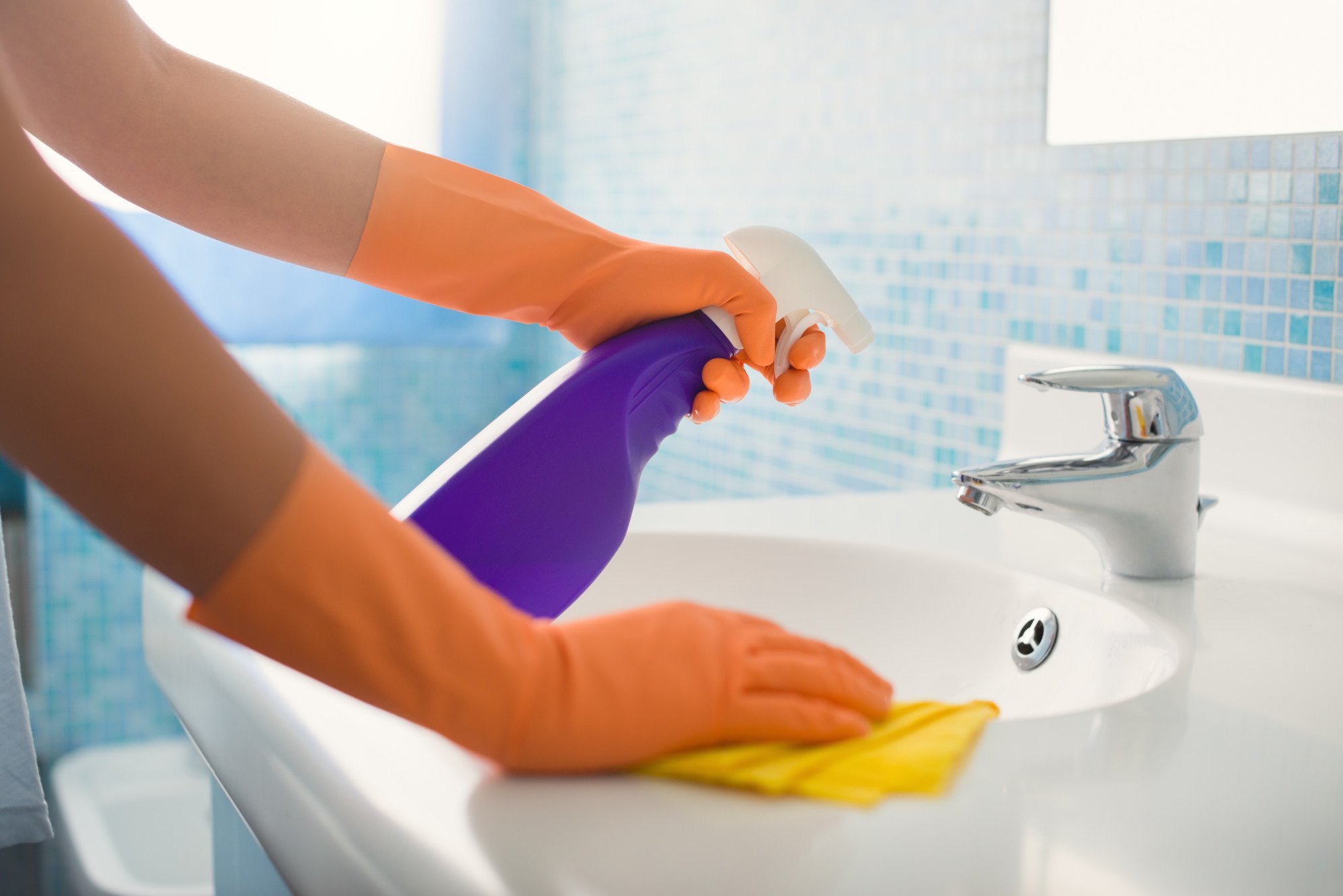There really is nothing worse than a dirty, stinky bathroom.
The fact of the matter is that bathrooms take a serious beating on a regular basis: from splashes of shaving cream to clumps of washed-off paint, from toothpaste spit-finds to post-poop flush eruptions.
In the end, though, it’s you — and only you — that has to live with the consequences of your bathroom having fallen into disrepair. Luckily, you’ve come to the right place to learn how to transform a disgusting bathroom into somewhere you not only want to step foot into but will happily spend time in.
Without further ado, here’s our comprehensive guide to troubleshooting and resolving the problem of a dirty bathroom.
Contents
- 1 Set A Budget
- 2 Assess the Current Condition
- 3 Plan the Design
- 4 Gather Supplies and Materials
- 5 Declutter and Clean
- 6 Make Necessary Repairs
- 7 Replace Fixtures
- 8 Paint or Wallpaper
- 9 Flooring
- 10 Vanity and Cabinets
- 11 Install New Accessories
- 12 Install Proper Ventilation
- 13 Regular Maintenance
- 14 Transform Your Disgusting Bathroom Today!
Set A Budget
Before you start planning any changes, take a close look at your financial situation. Calculate how much you can comfortably allocate to this project without causing financial strain. Be realistic about what you can afford.
Determine what aspects of your bathroom renovation are essential and which are more of a luxury or nice-to-have. This will help you allocate your budget accordingly.
Research the approximate costs of the materials and labor you’ll need for the project. Consult with contractors or visit home improvement stores to get a better understanding of the price ranges.
In any renovation project, unexpected issues can arise, such as hidden plumbing problems or structural issues. To account for these surprises, it’s a good idea to set aside a contingency fund within your budget.
Assess the Current Condition
Begin by thoroughly inspecting every aspect of your bathroom, including walls, floors, ceiling, fixtures, and plumbing. Look for signs of damage, wear and tear, or any other issues that make the bathroom disgusting.
Examine plumbing fixtures, pipes, and connections for any signs of water leaks. Look for water stains on walls, ceilings, or floors, as these can indicate ongoing issues.
Pay attention to the structural integrity of the bathroom. Check for any sagging floors or ceilings, as this could be a sign of underlying problems. Look for cracks in walls or tiles that may indicate structural issues.
One of the most common problems in bathrooms is mold and mildew. Check corners, grout lines, and areas around sinks and tubs for any signs of mold growth. Mold can be harmful to health and should be addressed promptly.
After assessing the current condition, prioritize the issues based on their severity and importance. Address critical problems like water leaks and mold growth first. Then followed by functional and aesthetic improvements.
Plan the Design
Ask yourself questions like what you want to achieve with this transformation. Consider your budget for the design elements as well.
Identify the style you want for your bathroom. It could be contemporary, traditional, or classic. Select a color palette that complements your chosen style and creates the ambiance you desire. Consider factors like lighting, as colors can appear different under various lighting conditions.
Determine the layout of your bathroom, taking into account the existing plumbing and electrical connections. Consider whether you want to keep the current layout or make changes to improve functionality.
If you’re unsure about the design or need professional guidance, consider hiring an interior designer or architect who specializes in bathroom renovations. They can help you create a cohesive and aesthetically pleasing design plan.
Gather Supplies and Materials
Before you start buying materials and tools, look at your design plan to make sure you know exactly what you need. Make a list of everything you need to buy and put it into categories to make it more organized.
Measure the size of your bathroom and any other places that need tiles, paint, or flooring. Calculate how much you’ll need so you don’t buy too much or run out of materials in the middle of the job.
Choose the quality of the items you want to use. It’s important to find a good balance between quality and cost. Invest in durable, water-resistant materials for places like the shower. Paint and decorations, on the other hand, may give you more freedom.
Find the things on your shopping list at local home improvement shops, specialty stores, and online. Compare costs and reviews from other customers. If you can, try going to real shops to look at things in person. Look out for sales and savings.
Declutter and Clean
Decluttering and cleaning your bathroom is an essential step before starting to renovate or transform your disgusting bathroom. Start by removing all items from your bathroom. This will give you a clear workspace and allow you to access all areas for cleaning.
As you remove items, sort them into categories. Decide what you want to keep, what you can discard, and what can be donated or relocated to other areas of your home.
For a clean and clutter-free look, minimize the number of items you keep on display. Reserve counter space for essential items only, such as hand soap and a toothbrush holder.
After deciding what you want to keep in your bathroom, you can start cleaning. Start by dusting all surfaces. Use a microfiber cloth or duster to capture dust effectively.
If you have shelves or cabinets, remove items from them so you can thoroughly clean both the interiors and exteriors. Clean mirrors using a glass cleaner or a mixture of water and white vinegar. Wipe them down with a lint-free cloth for a streak-free shine.
For bathroom cleaning, make sure to use an appropriate bathroom cleaner to scrub all surfaces. Pay special attention to areas with soap scum or hard water stains.
For tile floor cleaning and waxing, you can use a proper tile cleaner and an environment-safe wax. You can also use a mixture of baking soda and water or a specialized grout cleaner. Scrub with a brush or an old toothbrush to remove stains and buildup.
Clean the toilet bowl, seat, and tank with a toilet bowl cleaner. Don’t forget to clean the exterior of the toilet as well as the flush handle.
Empty the bathroom trash can and replace the liner. Make sure to discard any items that you’ve decided to throw away during the decluttering process.
Make Necessary Repairs
If you discover any leaks or drips, identify their source. It could be a loose connection, a worn-out washer, or damaged pipes. Tighten connections or replace faulty parts as needed.
If you find water damage on walls, ceilings, or floors, it’s essential to address the underlying issue. Identify the source of the leak and repair it. You may need to replace damaged drywall or flooring, depending on the extent of the damage.
Inspect all electrical components. Ensure that they are in good working order and meet safety standards. If you encounter any electrical problems, it’s best to hire a licensed electrician to make the necessary repairs.
If there are holes, cracks, or water damage on the bathroom’s drywall, patch and repair these areas. Use joint compound and sandpaper to create a smooth surface for painting or tiling.
If you notice any structural issues, such as sagging floors or walls, consult with a contractor or structural engineer. They can assess the problem and recommend appropriate solutions to ensure the bathroom’s structural integrity.
By addressing necessary repairs before starting the renovation, you’ll create a solid foundation for your project and prevent potential problems from worsening. This proactive approach will help ensure that your transformed bathroom is both functional and visually appealing for years to come.
Replace Fixtures
Identify which fixtures in your bathroom need replacement. Determine whether you want to upgrade them for a more modern or stylish look.
Opt for fixtures made from durable and high-quality materials. For example, choose solid brass faucets and stainless steel showerheads, as they are more resistant to corrosion and wear.
Measure the dimensions of your existing fixtures to ensure that the replacements will fit properly. Check that the new fixtures are compatible with your plumbing and electrical systems.
Before starting any fixture replacement work, turn off the water supply to the bathroom. Also, switch off the electricity if you’re replacing lighting fixtures.
Paint or Wallpaper
Choosing the right paint or wallpaper for your bathroom is an important step in its transformation. When choosing paint for your bathroom, opt for high-quality, moisture-resistant paint with a satin or semi-gloss finish.
These finishes are more durable and easier to clean than flat or matte paints. Consider paint labeled as “bathroom paint” or “kitchen and bath paint,” which is specifically designed to resist moisture and mildew.
If you prefer wallpaper, look for options that are designed for bathrooms or high-humidity areas. These wallpapers are often made from vinyl or other moisture-resistant materials. Additionally, choose wallpaper with a smooth surface or a washable finish for easier cleaning.
Flooring
Think about the specific needs of your bathroom when picking the type of flooring. If your bathroom is small, you can make it feel bigger by using tiles that are lighter in color or bigger.
For a master bathroom, you may want to put an emphasis on high-end finishes. In a family bathroom, it may be more important to have a tile floor that lasts and is easy to clean.
Also, keep in mind that flooring materials that cost more may last longer and need less upkeep. Make sure the subfloor is clean, level, and dry before you put down new flooring. Get rid of any old flooring, glue, or debris. Fix any damage to the flooring, and if your bathroom tends to get wet, you might want to add a moisture barrier.
Vanity and Cabinets
Think about how much counter space and storage you need. Think about how many people use the bathroom, what you need to store, and your daily routine.
Measure the space in your bathroom to make sure the vanity and cabinets fit well, and don’t make the room too small. Make sure there is enough space around doors, bathrooms, and toilets. Choose the look and style of the cabinet.
Choose whether you want to buy vanity cabinets that are already assembled or have custom cabinets made. Pre-built options are easier to set up, but custom cabinets give you more design choices.
Make sure there is enough airflow around the vanity and drawers to keep moisture from building up, which can cause mold and other problems over time. If you need to, put in an air fan.
Install New Accessories
Determine what accessories you need in your bathroom based on your daily routines and the size of the space. Consider your style preferences and how the accessories will complement the overall design.
This can include towel bars and hooks, shower caddies, toilet paper holders, soap dispensers, and others. Choose bathroom accessories that match the design and style of your bathroom. Whether you have a contemporary, traditional, modern, or eclectic design, there are accessories available to complement your aesthetic.
Once your accessories are installed, it’s important to test their functionality and adjust their placement as needed. This ensures that they are convenient to use.
Install Proper Ventilation
Place the exhaust fan or ventilation system in an optimal location within the bathroom. Ideally, it should be installed near the shower or bathtub and positioned to draw moisture-laden air away from the wet areas. If you have a separate toilet compartment, consider placing a fan there as well.
Ensure that the ventilation system you choose is appropriately sized for your bathroom. The CFM rating should be sufficient to exchange the air in the room multiple times per hour. A standard guideline is to have 1 CFM per square foot of bathroom area.
Regular Maintenance
Maintaining a clean bathroom on a regular basis is important to keep it working well and looking nice. This includes cleaning everything from top to bottom and every nook and cranny.
You should also make sure that there are no plumbing problems and ventilation problems. Maintaining your bathroom also means replacing any worn components and tightening fixtures.
Transform Your Disgusting Bathroom Today!
Your disgusting bathroom can be transformed in no time! Start by decluttering and getting rid of anything that is no longer needed.
Then, give your bathroom a deep clean and do some renovations if needed. Lastly, add some decor elements to make your bathroom the envy of everyone. Take action now to make your bathroom beautiful and inviting!
Is this article helpful? Keep reading our blog for more.



